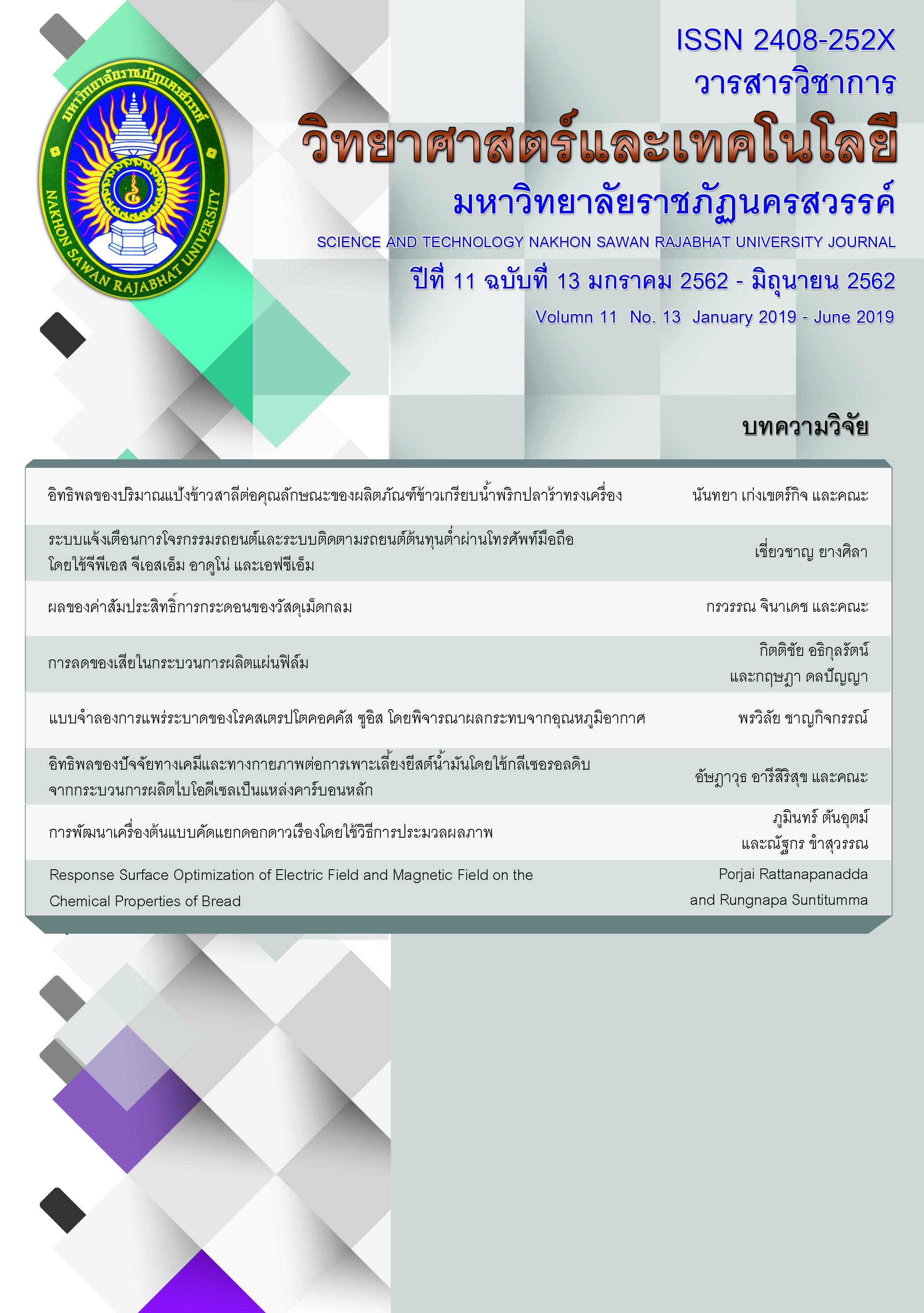อิทธิพลของปัจจัยทางเคมีและทางกายภาพต่อการเพาะเลี้ยงยีสต์น้ำมันโดยใช้กลีเซอรอลดิบจากกระบวนการผลิตไบโอดีเซลเป็นแหล่งคาร์บอนหลัก
Main Article Content
Abstract
The research aimed to study the effect of chemical and physical factors for cultivating oleaginous yeast Pseudozyma parantarctica CHC28 by using biodiesel-derived crude glycerol (BCG) as a sole carbon source. The seven variables (Glycerol concentration, (NH4)2SO4, KH2PO4, MgSO4, inoculum size, agitation rate, and temperature) were experimented and varied as two levels with Plackett-Burman experimental design (PBD). The maximum biomass, oil concentration, oil content, and oil production rate were obtained for 4.68 g/L, 2.53 g/L, 54.06% of dry biomass, and 0.84 g/L day, respectively. The results showed that yeast could utilize BCG for growing and producing microbial oil in all experiments. It demonstrated that the BCG could be used as a low-cost carbon source for cultivating P. parantarctica. Moreover, the experiment exhibited that glycerol concentration, MgSO4, and agitation rate were the first three highest contribution effect to biomass production for 49.46, 22.18, and 2.22%, respectively. While, glycerol concentration, KH2PO4 and agitation rate presented the first three highest contribution effect to oil concentration for 34.79, 11.22, and 10.73%, respectively. In addition, it was also observed that glycerol concentration, MgSO4, and agitation rate represented the positive effect on biomass and oil production while KH2PO4 provided a negative effect on oil production. This research demonstrated that BCG was an interesting inexpensive raw material for using as a carbon source of microbial oil production.
Article Details
References
Areesirisuk, A., Chiu, C., Liu, C., & Guo, J. (2015). A novel oleaginous yeast strain with high lipid productivity and its application to alternative biodiesel production. Applied Biochemistry and Microbiology, 51(4), 411–418.
Bligh, E. G., & Dyer, W. J. (1959). A rapid method of total lipid extraction and purification. Canadian Journal of Biochemistry and Physiology, 37(8), 911–917.
Bonturi, N., Crucello, A., Viana, A. J. C., & Miranda, E. A. (2017). Microbial oil production in sugarcane bagasse hemicellulosic hydrolysate without nutrient supplementation by a Rhodosporidium toruloides adapted strain. Process Biochemistry, 57, 16–25.
Chen, X.-F., Huang, C., Yang, X.-Y., Xiong, L., Chen, X.-D., & Ma, L.-L. (2013). Evaluating the effect of medium composition and fermentation condition on the microbial oil production by Trichosporon cutaneum on corncob acid hydrolysate. Bioresource Technology, 143, 18–24.
Cui, Y., Blackburn, J. W., & Liang, Y. (2012). Fermentation optimization for the production of lipid by Cryptococcus curvatus: Use of response surface methodology. Biomass and Bioenergy, 47, 410–417.
Dobrowolski, A., Mit
uła, P., Rymowicz, W., & Mirończuk, A. M. (2016). Efficient conversion of crude glycerol from various industrial wastes into single cell oil by yeast Yarrowia lipolytica. Bioresource Technology, 207, 237–243.
Duarte, S. H., Ghiselli, G., & Maugeri, F. (2013). Influence of culture conditions on lipid production by Candida sp. LEB-M3 using glycerol from biodiesel synthesis. Biocatalysis and Agricultural Biotechnology, 2(4), 339–343.
Ghorbel-Bellaaj, O., Hmidet, N., Jellouli, K., Younes, I., Maâlej, H., Hachicha, R., & Nasri, M. (2011). Shrimp waste fermentation with Pseudomonas aeruginosa A2: Optimization of chitin extraction conditions through Plackett–Burman and response surface methodology approaches. International Journal of Biological Macromolecules, 48(4), 596–602.
Gong, Z., Zhou, W., Shen, H., Zhao, Z. K., Yang, Z., Yan, J., & Zhao, M. (2016). Co-utilization of corn stover hydrolysates and biodiesel-derived glycerol by Cryptococcus curvatus for lipid production. Bioresource Technology, 219, 552–558.
Lin, L., Ying, D., Chaitep, S., & Vittayapadung, S. (2009). Biodiesel production from crude rice bran oil and properties as fuel. Applied Energy, 86(5), 681–688.
Manosak, R., Limpattayanate, S., & Hunsom, M. (2011). Sequential-refining of crude glycerol derived from waste used-oil methyl ester plant via a combined process of chemical and adsorption. Fuel Processing Technology, 92(1), 92–99.
Mathiazhakan, K., Ayed, D., & Tyagi, R. D. (2016). Kinetics of lipid production at lab scale fermenters by a new isolate of Yarrowia lipolytica SKY7. Bioresource Technology, 221, 234–240.
Polburee, P., Yongmanitchai, W., Honda, K., Ohashi, T., Yoshida, T., Fujiyama, K., & Limtong, S. (2016). Lipid production from biodiesel-derived crude glycerol by Rhodosporidium fluviale DMKU-RK253 using temperature shift with high cell density. Biochemical Engineering Journal, 112, 208–218.
Ratledge, C., & Wynn, J. P. (2002). The biochemistry and molecular biology of lipid accumulation in oleaginous microorganisms. Advances in Applied Microbiology, 51, 1–51.
Rossi, M., Buzzini, P., Cordisco, L., Amaretti, A., Sala, M., Raimondi, S., Matteuzzi, D. (2009). Growth, lipid accumulation, and fatty acid composition in obligate psychrophilic, facultative psychrophilic, and mesophilic yeasts. FEMS Microbiology Ecology, 69(3), 363–372.
Rymowicz, W., Fatykhova, A. R., Kamzolova, S. V., Rywińska, A., & Morgunov, I. G. (2010). Citric acid production from glycerol-containing waste of biodiesel industry by Yarrowia lipolytica in batch, repeated batch, and cell recycle regimes. Applied Microbiology and Biotechnology, 87(3), 971–979.
Saran, S., Mathur, A., Dalal, J., & Saxena, R. K. (2017). Process optimization for cultivation and oil accumulation in an oleaginous yeast Rhodosporidium toruloides A29. Fuel, 188, 324–331.
Sitepu, I. R., Garay, L. A., Sestric, R., Levin, D., Block, D. E., German, J. B., & Boundy-Mills, K. L. (2014). Oleaginous yeasts for biodiesel: Current and future trends in biology and production. Biotechnology Advances, 32(7), 1336–1360.
Tai, M., & Stephanopoulos, G. (2013). Engineering the push and pull of lipid biosynthesis in oleaginous yeast Yarrowia lipolytica for biofuel production. Metabolic Engineering, 15, 1–9.
Towijit, U., Amponpiboon, C., Sriariyanun, M., & Kongruang, S. (2014). Optimization of lipid production by oleaginous yeast using response surface methodology. Suranaree Journal of Science and Technology, 21, 321–328.
Wu, S., Zhao, X., Shen, H., Wang, Q., & Zhao, Z. K. (2011). Microbial lipid production by Rhodosporidium toruloides under sulfate-limited conditions. Bioresource Technology, 102(2), 1803–1807.


